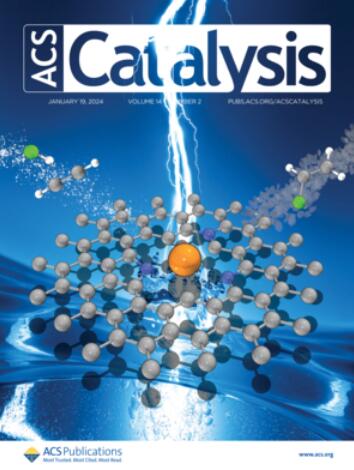Unraveling the Contrasting Dynamics of Reconstruction in Wolframite Cobalt Molybdate Polymorphs for Oxygen Evolution Reaction Electrocatalysis
IF 11.3
1区 化学
Q1 CHEMISTRY, PHYSICAL
引用次数: 0
Abstract
Understanding the dynamic structural evolution of active sites under operating conditions is crucial for designing high-performance electrocatalysts for the oxygen evolution reaction (OER). In this study, we explore the distinct reconstruction behaviors of two cobalt-based molybdate polymorphs, α-CoMoO4 and β-CoMoO4, with wolframite-type structures. α-CoMoO4 undergoes a gradual surface reconstruction, forming amorphous cobalt oxyhydroxide, consistent with the lattice oxygen oxidation mechanism (LOM). In contrast, β-CoMoO4 rapidly transforms into CoOOH through an acid group dissociation (AGD) mechanism involving the dissociation of MoO42– groups. Real-time tracking of the phase transition by cyclic voltammetry (CV) and quick-scanning X-ray absorption fine structure (QXAFS) reveals detailed kinetic insights into these processes. Density functional theory (DFT) calculations attribute the divergent reconstruction pathways to the competition between Co–O and Mo–O bond strengths, with stronger Mo–O bonds facilitating the rapid reconstruction of β-CoMoO4. Notably, surface-sensitive soft X-ray absorption spectroscopy (sXAS) demonstrates that β-CoMoO4 forms a higher concentration of μ2-OH-Co2+/3+ active sites, resulting in its intrinsic activity being 2.1 times that of α-CoMoO4. This work underscores the advantages of AGD-driven reconstruction for generating active sites and provides insights into the rational design of efficient OER electrocatalysts.

黑钨矿钼酸钴多晶在析氧反应电催化中的重构对比动力学研究
了解活性位点在操作条件下的动态结构演变对于设计高性能析氧反应(OER)电催化剂至关重要。在本研究中,我们探索了两种具有黑钨矿型结构的钴基钼酸盐多晶α-CoMoO4和β-CoMoO4的不同重构行为。α-CoMoO4逐渐进行表面重构,形成无定形的氧化钴,符合晶格氧氧化机制(LOM)。相反,β-CoMoO4通过涉及MoO42 -基团解离的酸基解离(AGD)机制迅速转化为CoOOH。通过循环伏安法(CV)和快速扫描x射线吸收精细结构(QXAFS)实时跟踪相变,揭示了这些过程的详细动力学见解。密度泛函理论(DFT)计算将重构路径的差异归因于Co-O和Mo-O键强度的竞争,更强的Mo-O键有利于β-CoMoO4的快速重构。值得注意的是,表面敏感软x射线吸收光谱(sXAS)表明,β-CoMoO4形成了更高浓度的μ2-OH-Co2+/3+活性位点,其固有活性是α-CoMoO4的2.1倍。这项工作强调了agd驱动的重构在生成活性位点方面的优势,并为高效OER电催化剂的合理设计提供了见解。
本文章由计算机程序翻译,如有差异,请以英文原文为准。
求助全文
约1分钟内获得全文
求助全文
来源期刊

ACS Catalysis
CHEMISTRY, PHYSICAL-
CiteScore
20.80
自引率
6.20%
发文量
1253
审稿时长
1.5 months
期刊介绍:
ACS Catalysis is an esteemed journal that publishes original research in the fields of heterogeneous catalysis, molecular catalysis, and biocatalysis. It offers broad coverage across diverse areas such as life sciences, organometallics and synthesis, photochemistry and electrochemistry, drug discovery and synthesis, materials science, environmental protection, polymer discovery and synthesis, and energy and fuels.
The scope of the journal is to showcase innovative work in various aspects of catalysis. This includes new reactions and novel synthetic approaches utilizing known catalysts, the discovery or modification of new catalysts, elucidation of catalytic mechanisms through cutting-edge investigations, practical enhancements of existing processes, as well as conceptual advances in the field. Contributions to ACS Catalysis can encompass both experimental and theoretical research focused on catalytic molecules, macromolecules, and materials that exhibit catalytic turnover.
 求助内容:
求助内容: 应助结果提醒方式:
应助结果提醒方式:


